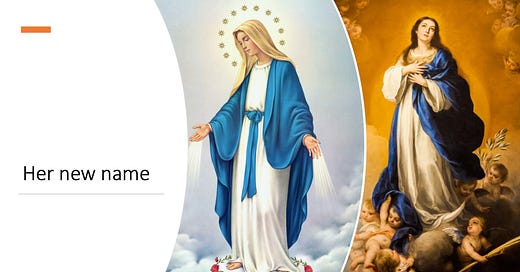Genesis 3:9–15, 20; Ephesians 1:3–6, 11–12; Luke 1:26–38
In today’s liturgy of the Word, we hear the famous conversation between God, our first parents who just transgressed God’s commandment, and the serpent who deceived Adam and Eve. At the core of this conversation is God’s pronouncement of judgment over the serpent that spells out its miserable end: “I will put enmity between you and the woman, and between your offspring and hers; he will strike at your head, while you strike at his heel” (Gen. 3:15). This passage is known as the first Good News in the Bible and it gave rise to a search for that woman and her offspring that dominates the entire Old Testament.
At the heart of the Gospel is a Greek word “kecharitomene” that is nearly impossible to translate. We are mostly familiar with its rendering as “full of grace”, but many contemporary English translations have “highly favored”, “truly blessed”, or even “beautiful with God’s beauty”. At the root of this verb is the word “grace” - “charis” in Greek - and it means “to endow with grace”. However, the grammatical form of the verb used here by the angel means that Mary has been bestowed with grace somewhere in the past and the result of this bestowment is her present state of grace.
The second reading comes from the letter to the Ephesians that includes the second appearance of our verb “to endow with grace”. We hear about God’s grace that he bestowed on us in the past in his son Jesus Christ. In our case, this past refers to the moment of our baptism, when we became holy and blameless before him. But how about Mary? In the Church’s declaration of Mary’s Immaculate conception declared by Pope Pius IX, we read: “In the first moment of her conception, by a unique gift of grace and privilege of Almighty God, in view of the merits of Jesus Christ, the Redeemer of mankind, Mary was preserved free from all stain of original sin”.
Some theologians indicate that with his greeting angel Gabriel change Mary’s name into “Full of Grace". That might be correct. There is a mysterious confirmation to that insight in history. The dogma of Immaculate Conception was declared in 1854; then four years later Blessed Virgin Mary appeared to a simple uneducated girl, Bernadette Soubirous, and introduced herself with a statement: “I am the Immaculate Conception”. The new name of Mary - “Full of Grace” - indicates that she is beautiful from the inside out, devoid of all evil and that her inner condition is incompatible with the presence of sin. In this way, Mary points to our glorious future - humanity set free from the stain of sin in God’s new creation.
Some scholars said that Mary is the first truly liberated woman, but her liberation was not achieved through social activism but by God’s grace. That grace has preserved her from the stain of original sin, but it has also prepared and empowered her for a unique role in the history of salvation. As the angel made it clear, Mary has been chosen to be the Mother of the Savior of the world. Her offspring fulfilled that ancient prophecy that we heard today - Jesus Christ crushed the head of the serpent through his death on the cross.
“O Mary conceived without sin, pray for us who have recourse to you.”




